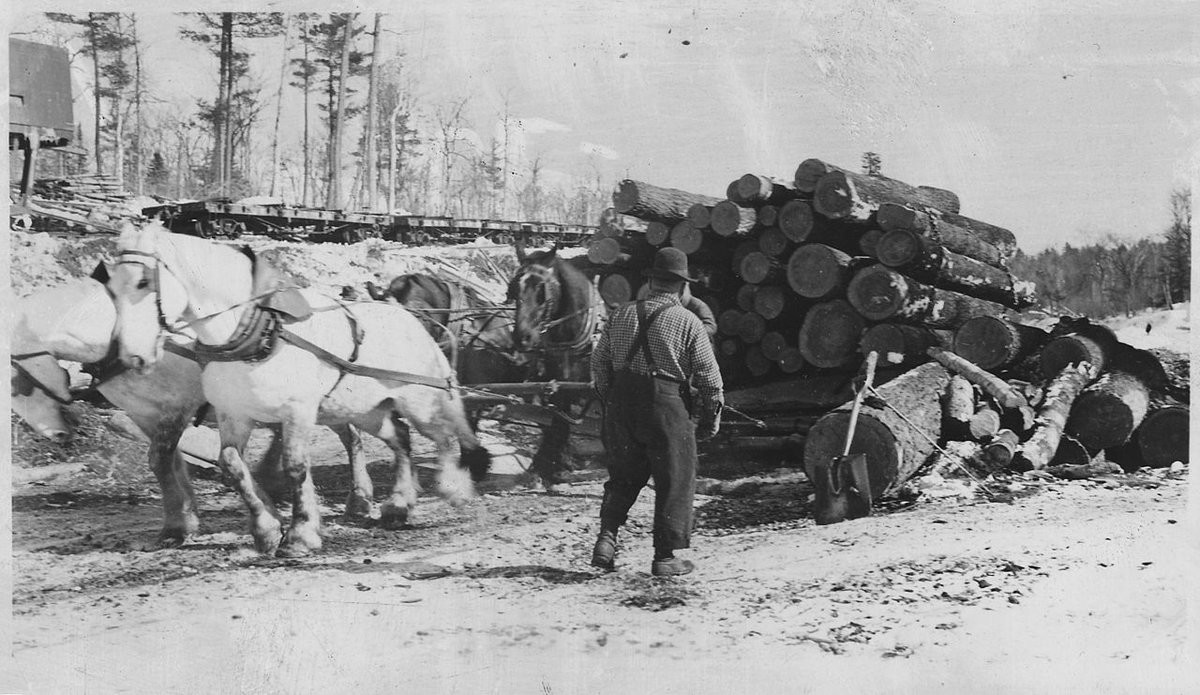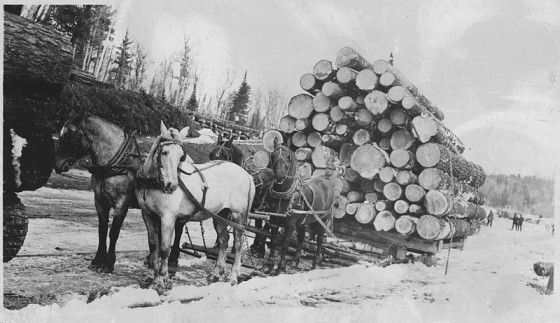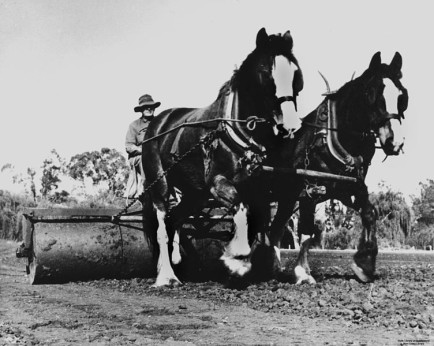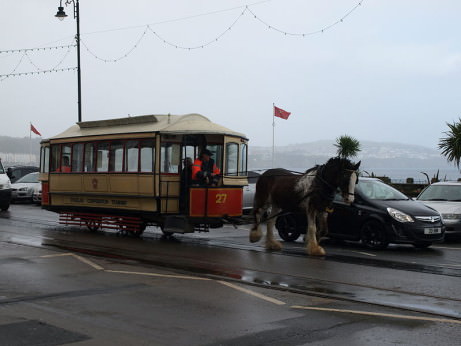Dang! Draft Horses are Amazingly Strong. Like, Can-Pull-a-Semi-Truck Strong.
A pair of Shires once pulled 50 tons, or the equivalent of a semi truck, plus an additional 20,000 pounds.
Dang! Draft Horses are Amazingly Strong. Like, Can-Pull-a-Semi-Truck Strong.
A pair of Shires once pulled 50 tons, or the equivalent of a semi truck, plus an additional 20,000 pounds.

According to author Donna Campbell Smith, The Book of Draft Horses: The Gentle Giants That Built the World, in 1924 a pair of Shire draft horses pulled 50 tons (100,000 pounds), which is 20,000 pounds more than the weight of a semi truck. Other sources we found recorded that they pulled only 45 tons. Only. Either way, that’s a lot of weight.
That same year, another Shire single-handedly, or single-hoofedly, pulled 29 tons (58,000 pounds) – the combined weight of three full-grown male African elephants and then some. The horse in question was from Liverpool and shod in that city’s preferred horseshoe style at the time, which meant he was basically wearing cleats. Still, that’s some impressive pulling power.
Draft horses were bred for big jobs, and the Shire”“generally considered the largest and heaviest of the bunch”“is no slouch in this department. The males’ average height is about five-foot-seven and they weigh in at about 1,800 pounds, but they can get even bigger. The breed originated in the lowlands of eastern England, mainly in Lincolnshire, Warwickshire, Leicestershire, Northamptonshire, and Cambridgeshire. (Understand why they’re named “Shire” now?) Heavier horses from northern Europe were brought to England in the 15th and 16th centuries and bred with smaller English horses in order to produce an animal strong enough to handle carrying a knight in a full suit of armor. This new breed was called the Great Horse or War Horse, according to the Shire Horse Society of England. Today’s Shire horses are believed to be the closest relatives to these bad boys, albeit with some additional breeding in the 1700s by an English agronomist named Robert Bakewell (who also developed Leicester sheep) for use in farming.
Draft horses, of all stripes (there are quite a few breeds, including, Clydesdales, Belgians, Brabants, Percherons, and the Suffolk Punch, among others) were invaluable in the 19th century when industrialization went hand-in-hand with the need to haul logs, beer, and newer, larger farm implements. The early 20th century saw the rise of draft-horse pulling contests, mostly at agricultural fairs, which continue today and have helped scientifically nail down just how strong these creatures really are.
If you’re the kind of person who needs a little visual proof before you’ll accept the facts, we’ve rounded up some photos and a video of draft horses in action.




And finally check out this pair, hauling 12,500 pounds at the Darke County Fair:
Follow us

This work is licensed under a Creative Commons Attribution-NoDerivatives 4.0 International License.
Want to republish a Modern Farmer story?
We are happy for Modern Farmer stories to be shared, and encourage you to republish our articles for your audience. When doing so, we ask that you follow these guidelines:
Please credit us and our writers
For the author byline, please use “Author Name, Modern Farmer.” At the top of our stories, if on the web, please include this text and link: “This story was originally published by Modern Farmer.”
Please make sure to include a link back to either our home page or the article URL.
At the bottom of the story, please include the following text:
“Modern Farmer is a nonprofit initiative dedicated to raising awareness and catalyzing action at the intersection of food, agriculture, and society. Read more at <link>Modern Farmer</link>.”
Use our widget
We’d like to be able to track our stories, so we ask that if you republish our content, you do so using our widget (located on the left hand side of the article). The HTML code has a built-in tracker that tells us the data and domain where the story was published, as well as view counts.
Check the image requirements
It’s your responsibility to confirm you're licensed to republish images in our articles. Some images, such as those from commercial providers, don't allow their images to be republished without permission or payment. Copyright terms are generally listed in the image caption and attribution. You are welcome to omit our images or substitute with your own. Charts and interactive graphics follow the same rules.
Don’t change too much. Or, ask us first.
Articles must be republished in their entirety. It’s okay to change references to time (“today” to “yesterday”) or location (“Iowa City, IA” to “here”). But please keep everything else the same.
If you feel strongly that a more material edit needs to be made, get in touch with us at [email protected]. We’re happy to discuss it with the original author, but we must have prior approval for changes before publication.
Special cases
Extracts. You may run the first few lines or paragraphs of the article and then say: “Read the full article at Modern Farmer” with a link back to the original article.
Quotes. You may quote authors provided you include a link back to the article URL.
Translations. These require writer approval. To inquire about translation of a Modern Farmer article, contact us at [email protected]
Signed consent / copyright release forms. These are not required, provided you are following these guidelines.
Print. Articles can be republished in print under these same rules, with the exception that you do not need to include the links.
Tag us
When sharing the story on social media, please tag us using the following: - Twitter (@ModFarm) - Facebook (@ModernFarmerMedia) - Instagram (@modfarm)
Use our content respectfully
Modern Farmer is a nonprofit and as such we share our content for free and in good faith in order to reach new audiences. Respectfully,
No selling ads against our stories. It’s okay to put our stories on pages with ads.
Don’t republish our material wholesale, or automatically; you need to select stories to be republished individually.
You have no rights to sell, license, syndicate, or otherwise represent yourself as the authorized owner of our material to any third parties. This means that you cannot actively publish or submit our work for syndication to third party platforms or apps like Apple News or Google News. We understand that publishers cannot fully control when certain third parties automatically summarize or crawl content from publishers’ own sites.
Keep in touch
We want to hear from you if you love Modern Farmer content, have a collaboration idea, or anything else to share. As a nonprofit outlet, we work in service of our community and are always open to comments, feedback, and ideas. Contact us at [email protected].by Andrew Amelinckx, Modern Farmer
December 17, 2015
Modern Farmer Weekly
Solutions Hub
Innovations, ideas and inspiration. Actionable solutions for a resilient food system.
ExploreExplore other topics
Share With Us
We want to hear from Modern Farmer readers who have thoughtful commentary, actionable solutions, or helpful ideas to share.
SubmitNecessary cookies are absolutely essential for the website to function properly. This category only includes cookies that ensures basic functionalities and security features of the website. These cookies do not store any personal information.
Any cookies that may not be particularly necessary for the website to function and are used specifically to collect user personal data via analytics, ads, other embedded contents are termed as non-necessary cookies.
Werry good
And people think they can’t pull carriages that weigh 2,000 to 3,000 pounds.